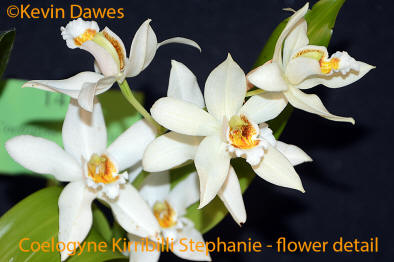Coelogyne Kirribilli Stephanie is another new (2015) primary Coelogyne hybrid orchid. A primary hybrid is one made by cross-fertilising two species plants. This time it was made using Coelogyne mooreana "Brockhurst' as the pod parent (mother) and Coelogyne brachyptera as the pollen parent. The flowers change quite a bit as the flowers mature.
The credentials of Coelogyne mooreana are well known among all orchid growers around the world because of its large, pristine white flowers with their glowing golden colour on the lip and in the throat. It is so very justifiably known as the 'Queen of the Coelogynes'.
The pollen parent (father) is a different story. It is one of the very small group of green coloured Coelogyne flowers. The most famous (and beautiful) of these being Coelogyne pandurata with its long, large cascading flower spikes. However, it is very tropical and hence only suitable for warm areas. Enter stage right, Coelogyne brachyptera. I have been so impressed with this plant. It produces an upright spike of medium size flowers that are a beautiful, fresh, apple-green colouring with just enough black markings to really highlight the green even further.
In this hybrid the dominance of Coelogyne mooreana is extremely strong (as it is in most hybrids) and the flowers are very similar to Coelogyne mooreana is all respects when the flower first opens. It has an upright spike with six flowers opening almost simultaneously. The lip colouring, keel structure, sepal and petal shapes and dimensions are carried through very strongly. The flowers are very slightly smaller and the sepals and petals slightly narrower.
Apart from this very slight reduction in flower size, the influence of Coelogyne brachyptera appears to be limited to a most delicate hint of apple green colouring throughout the flower. This is particularly noticeable in the opening buds but becomes more subtle as the flower matures. As the flower matures the column becomes quite green - bringing out the slightly green colouring of the flower.
Coelogyne brachyptera has also contributed to a slightly more upright and open flower. Surprisingly, the black lip markings are very suppressed but darker orange/brown markings become more evident as the flower matures. An important contribution has been the very openness of the flowers. This is an important trait to cultivate because many Coelogynes have downward facing flowers.
This hybrid was pollinated in my laboratory on 8th December 2009 and flasked when the pod was ripe, nearly a year later on 25th November 2010. After a number of reflaskings onto fresh sterile media they were taken out of their flasks on 11th September 2011 and it took almost four years more for them to begin to flower on 19th September 2015 - well worth the wait and another satisfactory conclusion to a fascinating part of an orchid hobby.
Negatives: At this stage it is a bit early to detect negatives in the plant's performance. The first spike the plant produced did not completely clear the furled leaf base from which it was emerging. I have noticed this minor fault with another Coelogyne mooreana hybrid - Coelogyne Amber. Despite the fact that the vast majority of the spike was well clear and its erectness minimised this negative aspect, it may be a breeding factor for future breeders to note.
Rating: ♦♦♦♦♦ I would award Coelogyne mooreana five stars and any hybrid from it would generally deserve serious attention. I am rating this new hybrid as five stars already because it has exhibited many of the traits that I seek in an orchid - attractive, large, perfumed, open flowers on a compact spike. More mature plants have continues to impress with many more spikes per plant. I am looking forward to the day this plant develops into a specimen size. Already this hybrid has held its flowers freshly for five weeks This is a noteworthy trait for a Coelogyne - especially the first flowering of a seedling. Additionally, it has continually oozed a pleasant, if slightly heavy perfume.
Registration: Registration with the RHS as Coelogyne Kirribilli Stephanie was recorded in September 2015. It is named after the eldest of my two beautiful grand-daughters.
Varieties: None known.
Hybrids: None registered
| < Coel Kirribilli Sarah Jean | Coel Kirribilli Susan Dixon > |

